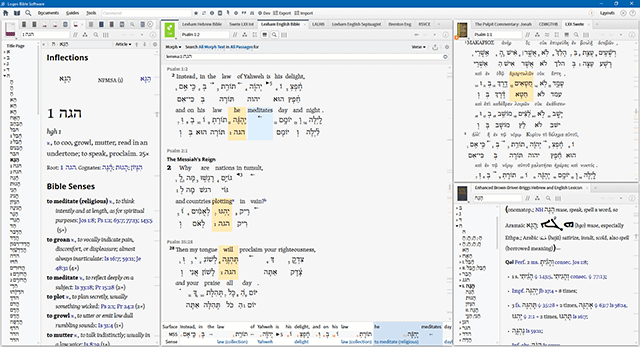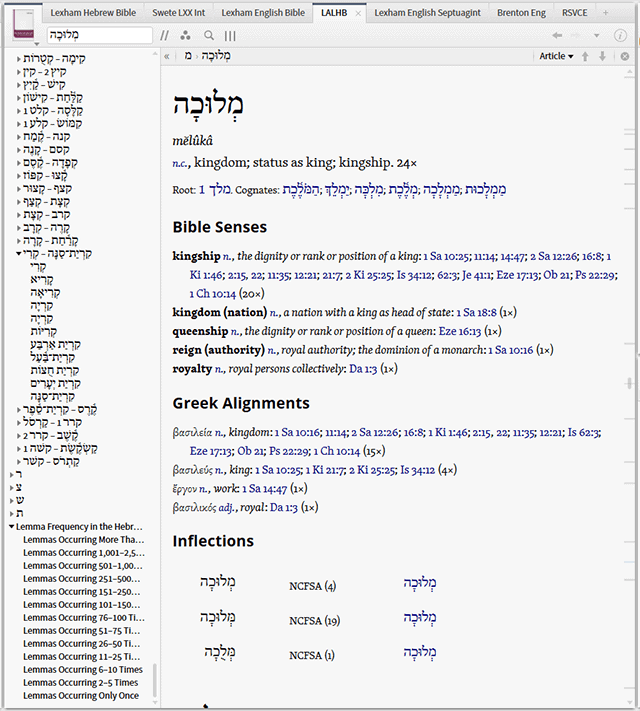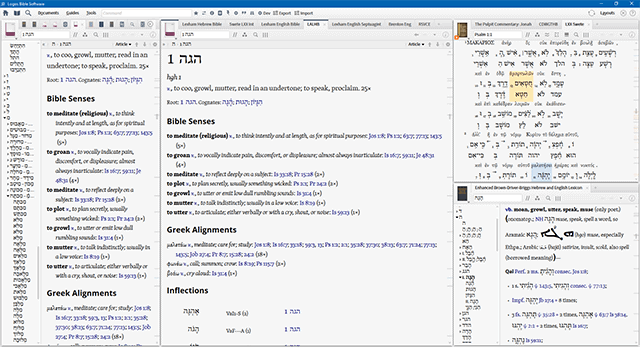Most of the time you look up a Hebrew word you probably don’t want the extreme depth and complication afforded by the top lexicons. Neither do you want to wade through a tight paragraph of tiny print full of abbreviations you don’t use often enough to remember. Paper lexicons were not designed for easy reading but for saving ink and paper.
Because it was built especially for Logos Bible Software, the new Lexham Analytical Lexicon of the Hebrew Bible (available via Pre-Pub) avoids these pitfalls. It could become your go-to tool.
I asked Isaiah Hoogendyk of our Content Innovation department to tell us what the LALHB is and how it can help Bible study.
What is the Lexham Analytical Lexicon of the Hebrew Bible?
We call this lexicon “analytical” because it includes more than just the usual Hebrew and Aramaic lexical forms, or “lemmas”, with a gloss and a few example references. Instead, for each entry in the lexicon there are three sections:
- The Bible Senses section groups all Bible references where the lemma occurs by Bible Sense.
- The Greek Alignments section groups all the Bible references by alignment to Greek words used in the Septuagint.
- The Inflections section lists all inflected forms for each lemma in the Old Testament. Each of these also includes their corresponding morphological parsing.
Who is it for?
This lexicon is an invaluable tool for people at all levels of Hebrew scholarship. It is for the amateur who is still learning the Hebrew script and its mysterious dots and squiggles. It is for the established pastor who wishes to communicate the beauty of the Hebrew language to his congregation. It is even for the seasoned scholar who requires an exhaustive survey of specific lemmas and their inflections throughout the Old Testament scriptures.
Why do we need another Hebrew lexicon?
With this project we are by no means attempting to replace the esteemed lexicons—such as HALOT (Hebrew and Aramaic Lexicon of the Old Testament) or BDB (Brown-Driver-Briggs Hebrew and English Lexicon)—that are already established tomes on the shelves of pastors and scholars alike. Instead, we are doing something quite different. The LALHB is unique in the field of Old Testament scholarship: while other analytical lexicons for the Hebrew OT do exist, they focus on a morphological analysis of every word in the Bible, arranged either by verse, or alphabetically by form. However, we have taken a data-driven, analytical approach to the next level by providing glosses for every word, and by organizing all occurrences of each lemma by Bible Sense Lexicon designation and by the Septuagint alignment (Old Testament in Greek) to its Hebrew original.
How does this resource complement existing lexicons?
Because print resources are bound by what can fit in a reasonably-sized physical volume, true exhaustiveness is impossible. But with this resource, we are able to provide an excellent complement to your favorite, trusted Hebrew lexicon. Again, breaking down the usage of the Hebrew by Bible Sense and by Greek alignment allows both students and teachers of the Bible to get a clearer picture of how a Hebrew word should be understood—both in its historical and linguistic context.
How can this lexicon give me insight into the Bible?
With each entry in the analytical lexicon, it is easy to see the shades of meaning and translation at a glance. This affords the user the benefit of mining the contextual sense of each Hebrew word. As an example, consider the Hebrew word הגה 1 found in the first two Psalms.
Psalm 1:2: Instead, in the law of Yahweh is his delight,
and on his law he meditates (הגה 1) day and night.
Psalm 2:1: Why are nations in tumult,
and peoples plotting (הגה 1) in vain?
Meditating and plotting are two very different things: the first has a positive connotation, the second can be negative, particularly in this context. Though it may be surprising to see the Psalmist use the same Hebrew word for these different activities, we can look at the top of the entry and read the lexical definition: “to coo, growl, mutter, read in an undertone.”
Considering this gloss and the contextual clues—“muttering” on the Law day and night versus the nations in tumult, “muttering” in vain—we can understand why the Bible Sense Lexicon tagged the occurrences differently: in Ps 1:2 the Hebrew is categorized as “to meditate (religious),” and the Ps 2:1 occurrence as “to plot”. (Both of these Bible Senses have other attestations on the same Hebrew lemma, which can be easily explored through this analytical lexicon.) Turning now to the Greek Alignments section, we see how the Septuagint authors treated this pair of occurrences: by using the same Greek lemma μελετάω, a word which unambiguously means “to meditate.”
I’ve only scratched the surface with this Hebrew word study, but I think I’ve shown how crucial it is to look carefully at the source text of every translation. By using the Lexham Analytical Lexicon of the Hebrew Bible, in collaboration with reverse interlinear Bibles, Bible Word Study and the Bible Sense Lexicon, the beauty and truth of the scriptures can be opened up before our eyes.
And there is so much more to explore in this lexicon. With the Inflections section, every inflected “surface” form is a headword, which means no matter where you find a Hebrew word, double-clicking it will send you to this lexicon. There is a section listing all lemmas by occurrence so you can see which words are used the most, which occur only a few times, and any that occur only once. Finally, it is easy to run a Bible Word Study or morph search from the Hebrew and Greek lemmas throughout, or run an inline search to find all Hebrew words using a particular Bible Sense or Greek lemma.
***
The Lexham Analytical Lexicon of the Hebrew Bible is still on Pre-Pub, which means you can get it for more than 30% off. Pre-order yours now.







